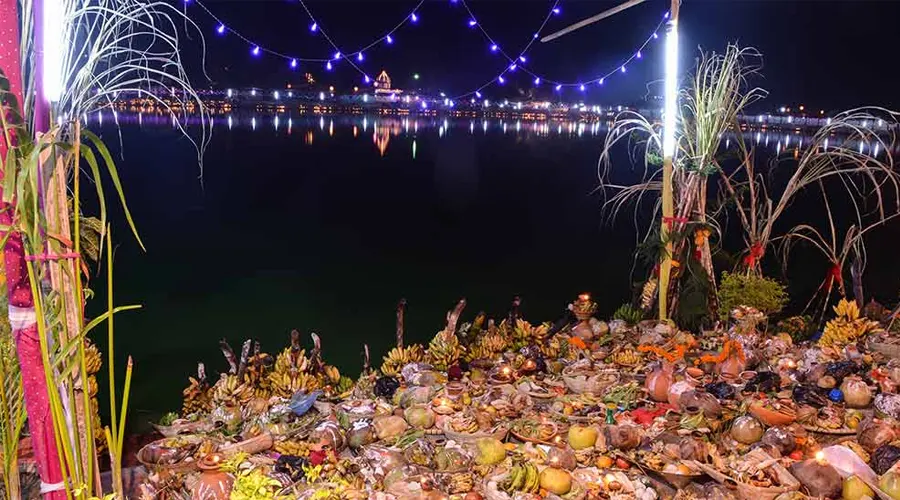Chhathi Maiya Mahaparva - Chhath Puja 2022
Chhath is an ancient Hindu festival historically native to Nepalis and Biharis of the Indian subcontinent, more specifically, the Indian state of Bihar along with West Bengal, Uttar Pradesh, Jharkhand, and the southern parts of Nepal.
Chhathi Maiya, also called Ranbay Maay in Mithila, is the sixth form of Devi Parvati and Lord Surya's Sister is worshipped as the Goddess of the festival.
This festival celebrates and offers gratitude to Lord Surya who represents the permanent source of life and sustenance on this earth.
Date and Celebration Time of Chhat Puja
Chhath Puja is celebrated every year on the Shashti Tithi of Shukla Paksha of Kartik month.
Chhath festival commences in the Kartik month, precisely six days following the 'festival of lights- Diwali.
From this day onwards worship of the sixth mother and the sun god is performed for the next four days.
This year Chhath Chhath Puja or Sandhya Arghya is on 30 October.
| Date | Day | Event | Tithi |
| October 28, 2022 | Friday | Nahai Khai | Tritiya |
| October 29, 2022 | Saturday | Lohanda and Kharna | Chaturthi |
| October 30, 2022 | Sunday | Chhath Puja, Sandhya Argh | Shashthi |
| October 31, 2022 | Monday | Suryodaya Argh | Saptami |
Rituals and Traditions of Chhath Puja
The rituals surrounding Chhath Puja are supposedly harsher when compared to other Hindu festivals. They involve strict fasting (without water), taking a dip in rivers/water bodies, standing in water and offering prayers, facing the sun for a prolonged period, and offering 'prasad' to the Sun during sunrise and sunset. Any food prepared during the festival will have no salt, onion, or garlic.
Celebration over 4 days
1st Day: Nahay Khay - This involves taking a dip in a holy water body and fasting all day. Ladies observing the fast can have 1 meal the whole day. The meal has to be home-cooked.
2nd Day: Lohanda and Kharna - A fast has to be maintained the whole day. It is broken after sunset and with prasad (popular: Kheer and Chapati). After this, another fast has to be observed for the next 36 hours without water.
3rd Day: Sandhya Arghya - Prasad is prepared at home and taken to the river in the evening and offered to the setting sun. Women wear turmeric yellow-colored sarees while performing this ritual.
4th Day: Usha Arghya - This day is spent preparing the prasad (offerings) at home, often consisting of a bamboo basket decorated with fruits, Thekua, and rice laddus. On the eve of this day, the entire household accompanies the devotee to a riverbank, pond, or other large body of water to make the Arghya offerings to the setting sun. At the time of arghya, Gangajal water is offered to Sun God and the Chhathi Maiya is worshipped with the prasad. After the worship of Sun God, Chhaith songs are sung in the night and the Vrat Katha is read.
After returning home the devotees perform the ritual of Kosi bharai together with the other family members. They take 5 to 7 sugarcanes and tie them together to form a mandap and beneath the shade of that mandap, 12 to 24 Diya lamps are burnt and thekua and other seasonal fruits are offered. The same ritual is repeated the next morning between 3 am and 4 am, and afterward, the devotees offer arghya or other offerings to the rising sun.
Significance of Chhat Puja
Chhath puja is dedicated to the sun god Surya. The sun is visible to every being and is the basis of life for all creatures on earth. According to Vedic astrology, Chhathi Maiya protects children from diseases and problems and gives those long lives and good health.
The morning glory of the rising sun and the majesty of the setting sun evoke a sense of power and awe among millions of devotees who come to pay obeisance to Lord Surya. Chhath puja in Bihar is also associated with wish fulfillment when a devotee carries out the rituals of the puja selflessly.


Comments (0)